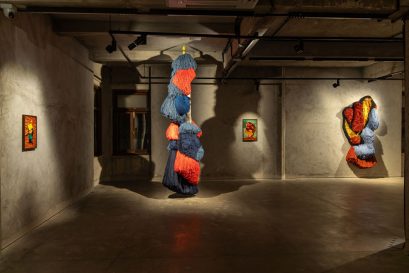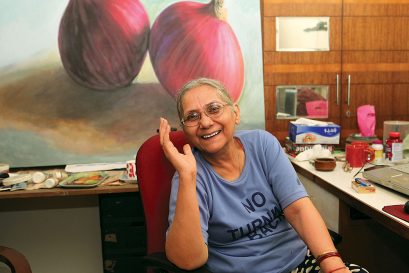When Literature Turns Hysterical
A video project by American artist Clayton Cubitt explores the battle between mind and body, and the tension between art and sex
 Sonali Kokra
Sonali Kokra
 Sonali Kokra
|
29 May, 2013
Sonali Kokra
|
29 May, 2013

A video project by American artist Clayton Cubitt explores the battle between mind and body, and the tension between art and sex
When a friend sent me a link to the videos, I didn’t bother opening it. I hadn’t heard of Clayton Cubitt and I had no idea what Hysterical Literature was. I remember thinking it was an interesting name for a video project, and for that reason alone, I put it in a folder marked ‘leisure time’. That leisure time came one week later. And I was stunned by what I saw.
When I click on the link, I’m greeted with an introduction—‘Hysterical Literature: a viral video art series exploring mind/body dualism, distraction portraiture, and the contrast between culture and sexuality. Viewed over 16 million times in 200 countries’—and a list of seven videos, each one featuring a woman holding a book or a tablet. The words don’t make much sense to me, except that this seems to be a hugely popular project.
I click on video one, and, at first glance, it seems that I’m watching an audition video of some kind. The background is pitch black; there’s a table with a pretty woman sitting behind it, reading from a book. All very nice, but all very boring. I’m still wondering how this managed to garner 16 million hits. I persevere and so does the woman.
Suddenly, she tenses. It’s an almost imperceptible change in her body language, but it’s there. I look more carefully. A few seconds later, there’s a catch in her voice and she trips over a word. She pauses as if to steady her breathing. Up until then, I’d only been paying half-hearted attention to the words—assuming it was an audition tape, I thought I was meant to hear the subtle inflections of her melodic voice—but suddenly, I’m much more attentive. Who is this woman? Is it the part she is auditioning for? Or is it the writing?
Her body goes through a series of reactions. She looks strained, as if fighting to stay in control. A couple of times, she has to make a visible effort to swallow and continue reading. She stutters more and more often, but doesn’t bother correcting herself anymore. She stops a few more times, giggles nervously, but continues. By the end, her hands are shaking and her shoulders are tense, but no matter how her body behaves, she keeps reading. Relentlessly. Stubbornly.
By now I’m thoroughly confused. My brain is unable to decide whether it ought to focus on her voice and words or the astonishing changes in her person. The whole exercise is so intense, it’s impossible to do justice to both at the same time. Within a few seconds, the winner chooses itself—there’s no way I can tear my eyes away from what they’re witnessing. The video ends with the woman announcing her name and that of the author and book she’s reading from. She’s smiling a smile that is part relief and part surprise—almost as if she didn’t know that this is how the audition would conclude.
Video two, three, four… seven are variations of the same theme. A woman starts reading, and by the end, there is a decidedly hysterical note in her voice as she announces her name. By video two, my sleep-deprived brain had exited ‘leisure’ mode and the words that had earlier made no sense told me everything I needed to know. I had just watched two women reach orgasm while reading a passage from a book of their own choice. How is that even possible? It’s possible when the artist’s assistant uses a vibrator on the women. Once I knew of its presence, I could hear its whir in a couple of the sessions.
There’s Amanda who can’t stop herself from screaming ‘Oh my god’ and whispering ‘fuck’ to herself as she buries her nose in her book. Her video ends with her asking the assistant under the table if she’d hurt her/him in the frenzy of her orgasm. Ditto for Solé, who throws her head back, screams and seems to continue sitting in the chair only by sheer force of will and holding onto its sides as if her life depends on it. Then there’s Danielle, who abandons her tablet altogether and cannot stop the little gasps that slip out. A fourth video shows Teresa, who looks a picture of self-control and assertiveness when she starts, but by the time her 9-minute-20-second video ends, is seen clutching the book in one hand and holding on to the edge of the table for support with the other.
Porn stars, writers, photographers, erotic models and burlesque dancers make up the subjects of the seven videos that have been released from the ongoing project. By the time I was done watching all the videos, I couldn’t decide how I really felt. Had I just watched porn, wrapped artistically with a bow tied neatly around it? Or was this feminism at its boldest, with seven women raising a collective middle-finger at everyone who had ever told them how and how much of the feminine form was okay to show? Or was it simply a wily artist trying to grab eyeballs by feeding the world’s favourite demand—for sex?
Here is an excerpt from an email-cum-Twitter-cum-phone interview with Clayton Cubitt, the artist behind Hysterical Literature:
Q What was the thought behind Hysterical Literature?
A Hysterical Literature is an extension and refinement of earlier video works I was doing that explored the concept of distraction and fatigue in the poses of portrait sitters. Today, everyone has a well-practised pose for ‘selfies’ and for Facebook. I was interested in how I might make a portrait that makes it impossible for the sitter to maintain this pose. So I did a video series called Long Portraits, which filmed subjects just sitting [and] making eye contact with the lens for five minutes or longer.
But this series, as much as I liked it, and as popular it became, was still in many ways too anonymous. It was interesting, but it was mute. It didn’t say anything about the sitter. I had also created an earlier video piece called Magic Interview where I attempted to interview a woman while she was being distracted by a vibrator. It was interesting, but it felt too close to an interrogation, and I wanted to remove myself from the process as much as possible.
So I asked myself, ‘What if the women could, in some way, have a conversation with themselves?’ I thought the best way to go about it would be to have them read a passage from their favourite book. It would allow self-expression without the pressure to pose or sound a certain way in a formal portrait or an interview. It would also remove me from the onscreen experience and make for a fascinating battle between the mind and the body.
The society that we live in tends to want to view art and sex through different lenses. Hysterical Literature was my attempt to blend the two concepts. So I put the art on the table and the sex under it.
Q But why only sex? There are so many other ways of expressing oneself without reserve…
A Sex is one of the most basic human drives, and one of the most powerful. But despite being as basic to human nature as eating or sleeping, it is often restricted, stigmatised or considered taboo. Female pleasure, in particular, has suffered stigmatisation throughout history. In fact, the project title derives from this historical stigma/misunderstanding of female pleasure—which was called ‘hysteria’. Women were sent to the doctor for ‘treatment’ with quack medical devices, including early vibrators.
As I said, the series started from the idea of a conceptual battle between mind and body, and I don’t think there’s any aspect of human culture that embodies this battle more than sex, so I chose sex as the distraction…both for the reader in the videos and the viewers who watch them.
Q How did you pick your subjects?
A Initially I asked women I knew or had worked with before to be a part of Hysterical Literature. But once the pieces became popular, I started receiving volunteer requests, some of whom I cast. I only cast women who are smart and strong. So in a way, it’s a bit of a self-selecting group because it takes courage to engage in such a vulnerable project with such a large audience. I’m humbled by the bravery and confidence of these women.
Q Did anyone you approached refuse to be a part of it?
A Several high-profile supporters of the project have been unable to participate due to concerns about being stigmatised in their careers despite being moved by the work and longing to be in it. It’s sad that this still happens in today’s day and age, especially given the origins of the project title. It seems that ancient taboos still require battling.
Q How much of what was going to happen was known to the women?
A They knew everything, and were complete collaborators in the process. They chose what to read, how to dress, how to do their make-up and hair. The only thing they didn’t know was how they would react once we started. We filmed only one take, continuously. So the audience and subject see her reaction together, at the same time.
Q Did you notice any significant change in your subjects after shooting their sessions? Anything they spoke to you about?
A Most of the subjects were surprised by how little they remembered of the actual reading. They felt like they had gone into a trance. The reading felt like a religious chant.
Afterwards, when they watched their session, they were just as amused as the viewers were—perhaps more so, because seeing yourself like this isn’t exactly normal and can be quite shocking.
A few of them have written quite eloquent accounts of their experience in the project. Once the sessions were published online, the subjects were often surprised by the number of people who were fans of the project and recognised them on the streets. I guess the internet turned them into some kind of micro- celebrities.
Q Was there ever a fear of the project being misunderstood as an exercise in voyeurism or exhibitionism?
A No. I knew that many people would understand the project and many wouldn’t. My role as the artist was to make it and let viewers figure things out for themselves… although I’d have no objection to the project being labelled either voyeurism or exhibitionism, as it deals heavily in both, as all art involving people does.
Q What happens next with this project?
A Is it still a work in progress or are you done filming all the sessions? I’m still filming sessions, and it’s an ongoing project. It’s about to enter a larger phase that’s bigger than my own original sessions. I’m building a dedicated website to house the sessions, the essays written about it, and the fan-made art derived from it. Part of this will also hopefully include sessions filmed in languages other than English, in countries other than the US. I hope to have this phase ready for release in June.
Q Aren’t you worried about how this project might be received in conservative cultures?
A Not really. Most cultures aren’t monolithically conservative or liberal. So I hope it helps forward-thinking individuals hoping to open up more conservative cultures to ideas of equality between the genders, and towards ending the shaming of sexuality. If the pieces can be an entertaining starting point for debate, I’m happy.
Clayton wasn’t exaggerating when he said that some of his subjects had written eloquent blog pieces on their experience. Danielle, the subject of video three and a photo artist herself, tells me via email, ‘The project was shot at a very particular point in my life last year. From then until now, I’ve confirmed a lot of what I consider important components of what happiness looks like to me. Sexual expression, honesty and transparency in my personal life and within my artwork are at the top of that list. Hysterical Literature is one of the several important things that led to these realisations.’
Stoya, a popular porn artist, has written on her blog: ‘My underwear lays on the floor out of frame. As I start reading, my disbelief is suspended. I forget what is about to happen. The first touch on my thigh sends all available blood to my vulva. I continue to enunciate properly, focusing on the text. I’ve broken a sweat. If this goes on for much longer my hair will be plastered to my head with perspiration as though I’ve been working out or engaging in acrobatic man/woman penetrative fucking… In the interests of art (and because this feels so beautifully filthy I don’t want it to stop yet), I hold out as long as I can. This section of the world that I inhabit slows down, zooms in. Like a stretched rubber band it suddenly contracts, and I am lovingly punched with an orgasm. ’
As I write, I am awed by the bravery of these women. Agreeing to let strangers, friends, and worse, family, witness you at your most intimately vulnerable can’t be an easy decision. I assume the reactions could be as unnerving as unexpected.
‘I think the most surprising reactions were those of the people from my past, those who knew a younger me,’ says Danielle. ‘Maybe they had a preconceived idea of who I was then, a person very different from the reality of who I am now. I think I’ve always been pretty radical, but I’m sure it still surprised some people.’
Solé, in her account, writes: ‘To my parents (who I know will read this), I hope that you are as proud of me as I am of myself… I pray that the whispers from conservative church folk will not seep into your psyche and that you’ll still love me as much as I have learned to love myself… I hope that if I become weak from any public backlash that I’ll have your shoulders to lean on…’
As a personal social experiment, I made a few friends watch a session each and tell me their reactions. Exhibit A was repulsed, angry and visibly upset. She tried to look away, focus on anything other than the woman’s stuttering and laboured breathing. But Clayton’s stark setting offers no respite.
There’s no background, no ambient sound, no movement other than the subject’s. The sessions could have been shot in someone’s living room, a professional studio or a Brazilian rainforest. There’s no way of knowing. There’s nothing to distract the viewer from the powerful exploration of the erotic that unravels in the video.
Exhibit B shyly admitted that the videos had turned her on more powerfully than some of the most graphic porn she’d ever seen. Exhibit C launched into a study of the particular passages that the subjects had chosen, and Exhibit D felt simultaneously empowered and vulnerable after watching the video.
Considering the cocktail of reactions I witnessed firsthand, I wonder what would happen if Clayton brought this project to India. As the artist finally gives in and tells me just as this article goes to print, it is only a matter of time before we find out.












More Columns
Why I Don’t Look Back in Anger Boria Majumdar
The Playful Past Rati Girish
“The day you say Modi is 'satisfied’, you can say you are paying homage to him” Open